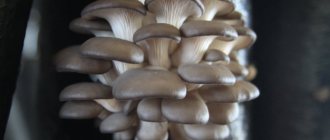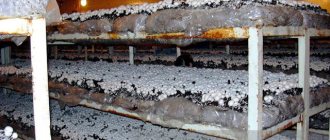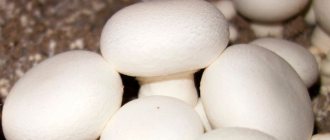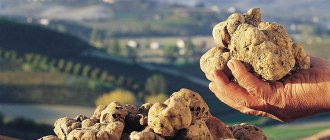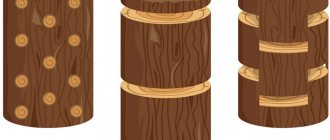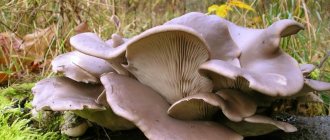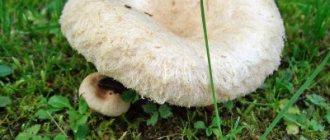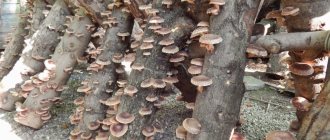Not so long ago, oyster mushrooms were a delicacy on the table of the average person, but now these mushrooms can be found at any time of the year, almost everywhere. Today, it has become an excellent alternative to champignons, both in price and quality, and in the ease of its cultivation.
Growing oyster mushrooms yourself is not as difficult as it seems. These mushrooms are quite unpretentious, do not require special care and are less susceptible to the harmful effects of pests than other varieties.
Oyster mushrooms can be grown in a greenhouse at any time of the year. All you need is a room, growing material and some free time to provide the mushrooms with proper care. Within a few weeks after planting, if everything is done correctly and the conditions are met, you will be able to enjoy your first harvest.
Is it possible to grow oyster mushrooms in a greenhouse with your own hands?
Growing oyster mushrooms in a greenhouse is not only possible, but also necessary. An indicator of high quality for these mushrooms is the absence of a stem, and such a result can only be obtained in the wild or in a greenhouse with natural light, and the coating material does not matter.
Did you know? Of all the mushrooms, oyster mushrooms are the most similar to meat in terms of nutritional content.
Cultivation is possible under the following conditions:
- natural light;
- lack of heat;
- high humidity;
- correct soil;
- access to fresh air.
Mycelium preparation
There is ready-made mycelium on the market. If you purchase one, you must follow all the specified points.
Here is information using boletus as an example:
| Planting depth | up to 30 cm |
| Watering | moderate, without stagnation of water or drying out of the soil |
| Boarding time | since March |
| Shoots | in 5–6 months, at the latest in 10 |
The following is a step-by-step instruction, which describes the alternation of layers of substrate, soil, and additives.
There is another way - you can get the mycelium yourself. To do this, the caps of adult mushrooms are twisted in a meat grinder or finely chopped with a knife.
Next you need to prepare a solution of manganese - 1 g per 10 liters with sugar (take 10 cubes). The crushed parts of the cap are placed in this liquid for 4 hours. The nutrient mixture with spores is ready.
Important! A mandatory measure when experimenting with growing mushrooms at home is to disinfect the premises. https://www.youtube.com/embed/3Z92zpAnr0c
Advantages and disadvantages
- The advantages of growing oyster mushrooms in a greenhouse include:
- low costs;
- no need for expensive equipment;
- no need for a large area;
- protection from infection due to isolation;
- the ability to grow for sale;
- high profitability;
- simplicity of technology;
- confidence in the quality of the product;
- the opportunity to get organic mushrooms;
- the pleasure of eating homemade food;
- no need to license and certify your activities;
- the ability to involve family members in care;
- rapid growth of oyster mushrooms;
- a greenhouse will protect your respiratory tract from fungal spores, mold and humidity, unlike home cultivation;
- the possibility of saving space thanks to layered cultivation.
- The disadvantages include:
- the use of physical labor to care for mushrooms;
- dependence of the harvest on external factors;
- there is an opinion (unconfirmed) about the need to use respirators and protective clothing when working with mushrooms;
- fungal spores can cause allergies;
- A truly profitable business is possible if there is a market.
Also read about the technology of growing champignon mushrooms in a greenhouse.
The right time to plant seedlings in a greenhouse
The best time to plant oyster mushrooms in a greenhouse is late summer, but they can also be grown at other times of the year. Mushrooms can be planted all year round together with other crops (preferably with cucumbers) or during free time from growing other plants.
Many gardeners have their greenhouses idle in winter because vegetables require additional lighting and heating, which increases their cost, while for mushrooms these requirements are much lower. Good results are obtained by growing in a greenhouse during periods of high humidity (spring, autumn). The problem can arise in hot summers, because oyster mushrooms cannot tolerate high temperatures and stop their vital activity.
Useful tips
To build a greenhouse and safely grow mushrooms in it, you should take into account a number of recommendations from experts:
- For the structural frame, the best material is aluminum, as it is lightweight and wear-resistant. In addition, such material is not afraid of corrosion, and mold will not form on it even in conditions of high humidity. For the same reasons, it is worth installing shelving and racks made of aluminum in the mycelium.
- In order to improve thermal insulation, the floor should be covered with foamed polyethylene or other material that has similar properties. In addition, it is necessary to pay due attention to sealing the greenhouse, since any cracks and holes in the shelter lead to a decrease in the heat level, and therefore to an increase in heating costs.
- The greenhouse in which it is planned to grow mushrooms cannot have a translucent or transparent roof. It needs to be built or converted in such a way that the incoming light is dim. To do this, you can use several tricks: paint the translucent ceiling with chalk;
- tint the roof and walls with special adhesive tape or mesh;
- curtain with synthetic translucent fabric.
If you need to organize additional lighting inside the greenhouse, you can install fluorescent lamps.
Basic requirements for a greenhouse
These mushrooms can be grown in a greenhouse for vegetables or in a specialized greenhouse for mushrooms.
The latter are of the following types:
- two-tier 4-flank St. Petersburg;
- Greek 7-flange model 1861;
- combined 4-flange Moscow gardeners.
- The following requirements apply to a greenhouse for growing oyster mushrooms:
- It should be warm, because mushrooms require stable heat to grow. You can insulate for the winter by installing a second shelter circuit.
- For growing in winter, additional heating is needed, optimally of the water type.
- It must be airtight so that drafts do not lead to sudden temperature changes.
- It is necessary to provide for the possibility of ventilation through vents or supply and exhaust ventilation (ventilation pipes).
- It should be possible to humidify the air by spraying water.
- It is necessary to provide protection from direct sunlight through the roof - install colored or translucent polycarbonate, make an additional contour from covering material, install curtains, whitewash the roof.
- To insulate the soil in winter, it is covered with foamed polyethylene with a metallized layer.
- To save space, you will need racks and shelves.
- There are no size requirements; it all depends on the scale of the planned sowing.
Important! The greenhouse where oyster mushrooms grow should not be heated with a gas burner, as this dries out the air.
How to grow porcini mushroom near your home
Mushroom pickers often pick overripe porcini mushrooms in the forest. Some people make their own liquid seed spore material from these mushrooms, and then water the ground with it in secluded places in their garden plot with suitable soil.
Mushrooms are chopped either using a knife or passing through a meat grinder. Mushroom mince is placed at the bottom of a trimmed 5-liter plastic bottle and filled with 4 liters of spring water at room temperature. Add 50 g of live baker's yeast, cover loosely with several layers of gauze and leave for 2 weeks in a warm, unlit place. 100 g of the resulting mixture is diluted with 2 liters of settled water and poured over the area. If the soil is not suitable, then it is prepared, bringing the composition as close as possible to the soil where the mushrooms were picked.
The first signs of mycelium growth will appear in a few months, and the first mushrooms will appear in a year and a half.
Features of growing oyster mushrooms at home
If you want to grow oyster mushrooms, you need to familiarize yourself with planting technology.
How to prepare seedlings
To plant oyster mushrooms, you need to buy mycelium. Before planting, it and the substrate are kept in the same room for a day so that both are at the same temperature.
As a substrate you can use:
- freshly cut stump;
- undried timber;
- a mixture of 45% cereal straw, the same amount of cabbage stalks, 6% wheat bran, the rest is filled with plaster or chalk;
- a mixture of 90% sunflower husks, 5% soy flour, gypsum or chalk;
- a mixture of hardwood sawdust and wood shavings (45% each) with 8% rye or wheat bran, gypsum or chalk;
- a mixture of 30% sawdust with 60% buckwheat husks and beer grains;
- a mixture of 85% wheat straw with 13% grass legume meal and chalk.
To protect the future harvest from mold, add 10 g of Fundazol or Benlat per 100 kg of substrate, and 2.5 g of Dimilin per 100 kg of substrate to protect against fungus flies and mosquitoes. All components of the substrate should not be larger than 5 cm.
The substrate is treated with hot water: mix all the components, put them in polypropylene bags, put them in a container with hot water and leave for 5 hours. Then the bags are taken out, laid down on a slope, placed under a load and allowed to drain. The procedure will be completed when no water comes out of the substrate squeezed in your hand.
The prepared substrate has the following characteristics:
- humidity - 70–80%;
- temperature - +25°C;
- structure - loose, crumbly.
Stumps and timber, if they are not freshly cut, can be soaked in water for a day.
Important! Oyster mushrooms do not grow on waste from coniferous trees.
Transplanting
If oyster mushrooms are grown in a substrate, then special bags will be required, the dimensions of which are 0.5 × 1 m. On each side of the bag, 12 slits with a diameter of 10 cm are made. A layer of the substrate, a little mycelium kneaded by hand, is poured into the bag, and the layers are repeated, carefully compacting each one. In total, 1 bag requires 300–450 g of mycelium. The tied bags are placed in the greenhouse at a distance of 0.5–0.6 m from each other.
When growing on stumps or bars, you need to drill about 8 holes in them from above (on the side where the tree grew) and the same number at the edges, diameter - about 2 cm. Mycelium is poured into the holes, compacted well, filled with garden varnish or covered with plasticine .
A hole 5 cm deep is dug in the ground, a stump is placed in it, sprinkled on the sides, and the soil around the stump is watered. Or you can dig a hole like this, pour sunflower husks and mycelium into the bottom, water it, put a stump on top, and lightly sprinkle it with soil. The distance between stumps is at least 35 cm.
Video: how to grow oyster mushrooms on stumps
How do you know when the humus is ready?
The color of the manure becomes dark brown, has a fine-grained structure, grass may be visible and there is no odor. These are four signs of ready-made humus.
After this, compact the resulting mixture to 20 centimeters.
Now it's time to start planting mushrooms. Place them in a checkerboard pattern 30 centimeters apart. When all the mushrooms are planted, add manure to them and compact them lightly.
After 15-20 days, as a rule, the mycelium takes root, and the soil is covered with earth to a thickness of 5 centimeters.
Rules of care
When caring for mushrooms, you need to remember about temperature, fresh air, watering and a substrate rich in necessary substances.
Temperature
Oyster mushrooms should grow at temperatures in the range of +23...+25°C. To stimulate growth, it is recommended that 2 weeks after planting, when the substrate turns white, turn off the heating and bring the temperature to +2...+4°C. After 2 days, the heating is turned on and the temperature is maintained at +15°C.
Low temperatures promote slow but high-quality growth of mushrooms. They become larger, with short legs. It is necessary to remember that these mushrooms need access to fresh air, and regularly ventilate the greenhouse.
Did you know? The largest number of oyster mushrooms grown in one place
—
473 pcs.
How to water
Watering is needed by drip; it is better to use rain or warm melt water. You can spray water manually or using special equipment. Air humidity should be maintained between 75–90%. Watering is not carried out at temperatures below +10°C. If mushrooms are planted on stumps or bars, then water the soil around them.
What to feed
For feeding, waste from the woodworking industry and agriculture is used:
- sawdust;
- wheat or rye bran;
- soy flour;
- herbal flour;
- beer grains;
- gypsum;
- chalk.
They are added to the substrate during planting.
Champignon
These mushrooms require virtually no sunlight to germinate. They are also undemanding, like oyster mushrooms, and can even grow near fruit trees. An important condition for growing champignons is the use of soil rich in organic components.
To prepare the soil mixture, you need to prepare 12 kg of gypsum and lime, 50 kg of cow or horse manure, 20 kg of straw. The ingredients are thoroughly mixed to form a pile. It is watered with water and compacted tightly. The mixture is covered with plastic wrap, leaving it for 2-3 weeks. The ammonia smell should completely disappear.
Now you need to dig a trench 30 cm deep. It is filled with the prepared substrate. The soil is watered with plenty of water. The mycelium is placed in a trench. It is covered with straw. The ambient temperature should be around 20°C.
The soil on which the mycelium grows is moistened, but not compacted. The harvest can be harvested in just 2 months.
Harvest and storage
The first harvest appears on the 27-30th day from planting or about a week after you notice the primordia - small tubercles. Use a sharp knife to cut off the oyster mushrooms and carefully collect all the remains of the legs. Not earlier than in a week, the mushrooms will grow again. In total, it will be possible to collect up to 4 harvests in 2 months.
Next, new mycelium is planted. The harvested crop is poured into a large wooden box 2 m high and transferred to a cold room for blast cooling, after which it is stored in a refrigerator.
So, you can grow oyster mushrooms in a greenhouse, and this process is not accompanied by any special difficulties, so even beginners can do it. By observing the requirements for the greenhouse and the conditions inside it, anyone can get their own harvest. This option is ideal for those whose greenhouse sits idle without load in winter.
Mycelium
Planting mycelium is grown in specialized farms. It is grown in 2-liter jars containing compost weighing 700 g. This material is enough to sow 1.5 square meters. m. mushroom ridge. The mycelium can be stored in the refrigerator for about a year.
A grain version of mycelium based on a mixture of rye and wheat is also produced. Mycelium is sold in plastic bags and supplied with instructions. Which material is better - opinions differ on the forums.
